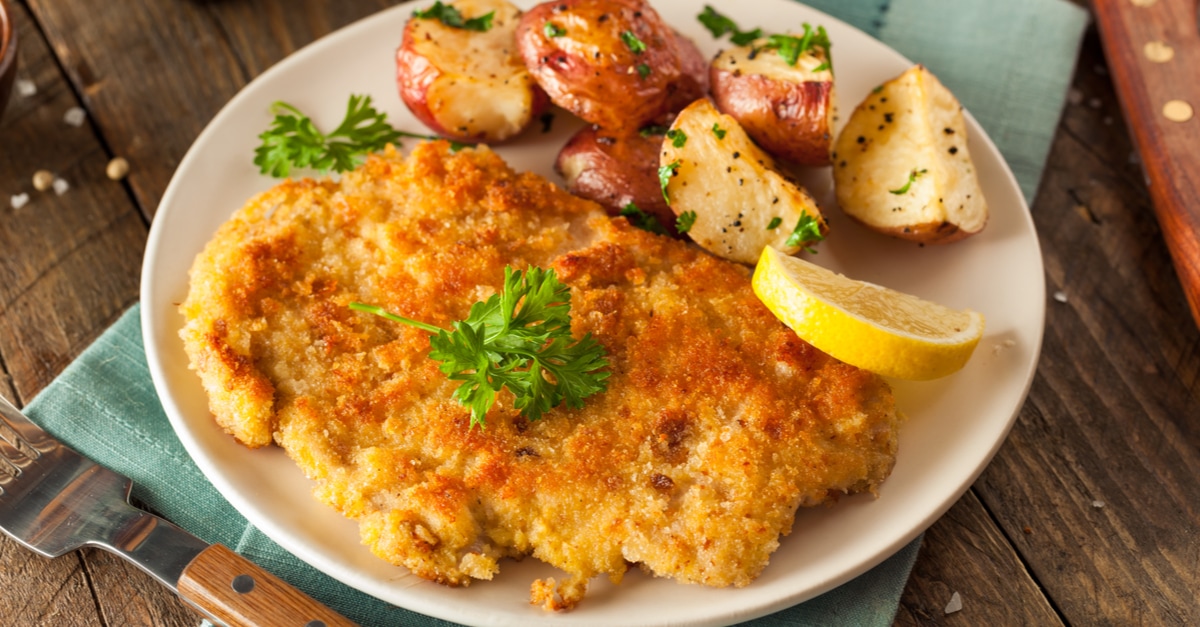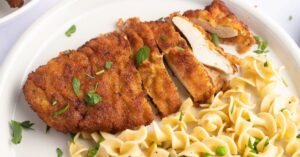From the crunchy, golden breadcrumb crust to the tender and juicy veal inside, Wiener schnitzel is the kind of dish I could eat every single day.
For me, it was definitely love at first bite.

But no matter where you eat it, you won’t be disappointed.
Wiener schnitzel is a simple, humble, and delicious meal that pairs well with everything from a side salad to cheesy pasta or creamy potato salad.
What is Wiener Schnitzel?
Let me preface this by saying a wiener, in Austria and Germany, at least, doesn’t refer to a hot dog.
And while schnitzel is often considered a German dish, it actually originated in Austria. In fact, “wiener” is German for “from Vienna!”
Wiener schnitzel is a Viennese dish of thin veal cutlets breaded and fried until golden.
“Schnitzel” refers to meat slivers or cutlets and can mean anything from pork to chicken. The word “Weiner” refers explicitly to the dish from Vienna, which is always made with veal.
Austria is so strict about this dish that it’s protected under Austrian law!

Ingredients
Here are the ingredients you’ll need:
- Veal. Authentic Wiener schnitzel exclusively uses veal. If that’s an issue for you, use pork or chicken breasts. The important thing is that they’re pounded thin, so the meat is nice and tender.
- Flour. The double coating is important to help lock in the meat’s moisture.
- Eggs. The binder that adheres the breadcrumbs to the veal.
- Parmesan, parsley, salt, pepper, nutmeg, milk. Seasonings are stirred with the eggs for flavor.
- Breadcrumbs. They serve as the coating of the schnitzel that turns it into a crunchy golden outer shell when fried properly.
- Butter. For frying.
- Lemon slices. For garnish
How to Make Wiener Schnitzel
This recipe is pretty straightforward. You just need to remember to start at least an hour before you want to eat or prep the meat in the morning if you want it for dinner.
Then, after a few minutes of hard work, you’ll be rewarded with a crunchy and savory work of art!
Step 1: Prepare the veal. Cover the cutlets with plastic wrap and pound them thin with a mallet or rolling pin.
You’ll want the meat to be at least 1/4-inch thick. If you can flatten it further to 1/8 inches, even better. Since you’ll be shallow-frying the veal, it’s better to cut them thin.
Step 2: Prepare the breading assembly line.
Take 3 shallow bowls. Pour flour in the first and breadcrumbs on the second. Add parmesan, eggs, parsley, salt, pepper, nutmeg, and milk into the third bowl and whisk to combine.
Step 3: Coat the veal. Dredge the veal in flour and shake off the excess. Dip it into the egg mixture until well-coated. Next, cover all sides with breadcrumbs.
Place the battered cutlets on a plate and cover with plastic wrap.
Step 4: Chill the veal. This part is super crucial because it helps the breadcrumbs adhere to the meat.
Let it chill for at least 1 hour, but better if you do so overnight.
Step 5: Shallow-fry the veal.
Melt butter in a large skillet over medium heat. Pan-fry the cutlets, 1-2 at a time, depending on the size of your skillet, until golden brown.
This will take about 3 minutes per side.
When frying, constantly move the pan in a circular motion to help cover the schnitzel in bubbling butter. This will help make the breading crunchy and golden.
Pro-tip: if you don’t want to use butter, you can use any oil with a high smoke point, such as canola, peanut, avocado, and grapeseed oil.
Step 6: Serve the schnitzel on a platter. Pour leftover butter over the schnitzel and garnish with lemon slices. Enjoy!

Tips for the Best Wiener Schnitzel
Before you head to the recipe card, check out some of my best wiener schnitzel tips:
- Flatten the meat 1/4-inch thick. You can even go slightly thinner if you prefer. Remember: the thinner the meat, the faster and more evenly it’ll cook.
- No meat tenderizer? Use a rolling pin! Just be sure it’s covered with plastic wrap. If you pound it without protection, it’ll easily rip apart. A mallet also works.
- Season appropriately. For more flavor, season both sides of the veal with salt and pepper before coating them in flour. Sea salt is best.
- Whisk the eggs with cream. Doing so will make them fluffier. Or, if you need it dairy-free, almond milk will work, too.
- Fry one schnitzel at a time. Overcrowding the pan will cause the temperature of the oil to drop. That will steam the meat instead of fry it.
- Use oil with a high smoke point. The recipe calls for butter, and that’s what I prefer. However, if you use oil instead, ensure it’s a high smoke point oil to prevent burning. Examples are grapeseed, canola, avocado, and peanut oil.
- Cook using the soufflieren method. This is an authentic German cooking technique that helps crisp the batter. Constantly move the pan in a circular motion to help cover the schnitzel with oil.
- Keep the schnitzels warm. Place cooked schnitzels in a warm oven while you’re frying the rest. Lay them on a tray without overlapping to keep them crispy.

Schnitzel Varieties
As mentioned, Wiener schnitzel is always made with veal. But, regular schnitzel can be made with whatever meat you prefer.
You can even use tofu and make vegan schnitzel if you want!
Here are other popular types of schnitzels you may want to try:
- Surschnitzel – it features salt pork cutlets in brine instead of veal.
- Schnitzel Roulade – rolled pork cutlets with a cheese and spinach filling.
- Cordon Bleu – my personal favorite! It’s a chicken schnitzel with a layer of ham and cheese in the middle.
How to Serve Wiener Schnitzel
- On its own, with just a spritz of lemon to cut through the richness of the veal.
- Swimming in schnitzel sauce – a thick and savory gravy with earthy mushrooms and sweet shallots.
- With pasta. Place it on top of any kind of tomato-based pasta.
- With potatoes. You can’t go wrong with mashed potatoes, fries, or potato rosti.
- With a serving of coleslaw or salad on the side for a light meal.
More Austrian and German Recipes You’ll Love
20 Popular Austrian Foods to Try
20 Traditional Austrian Desserts
21 Popular German Appetizers
24 Authentic German Recipes
20 Best German Side Dishes










